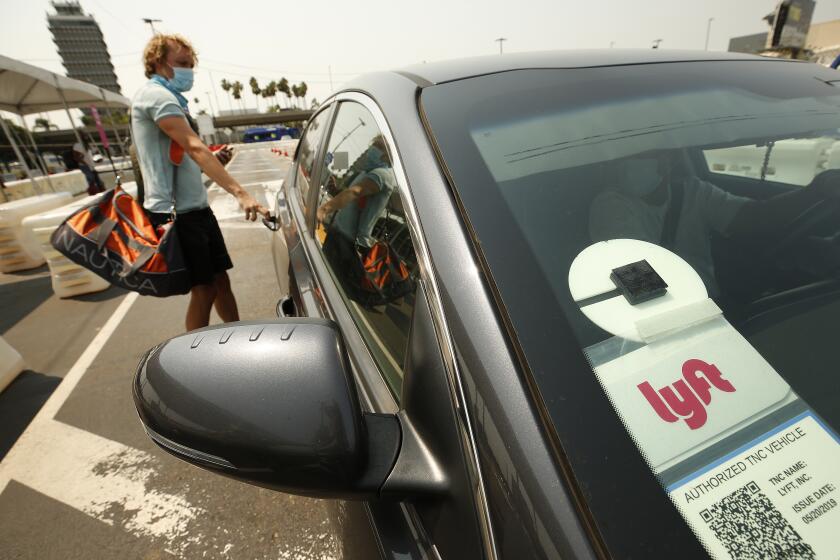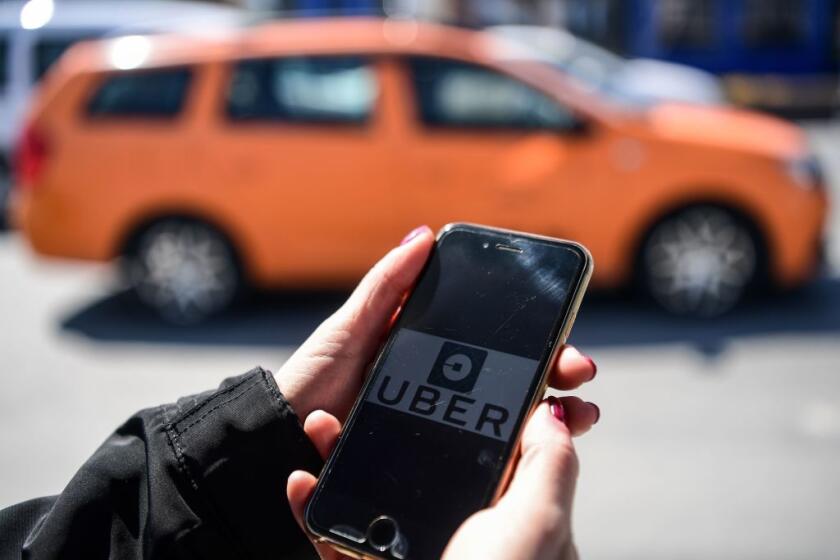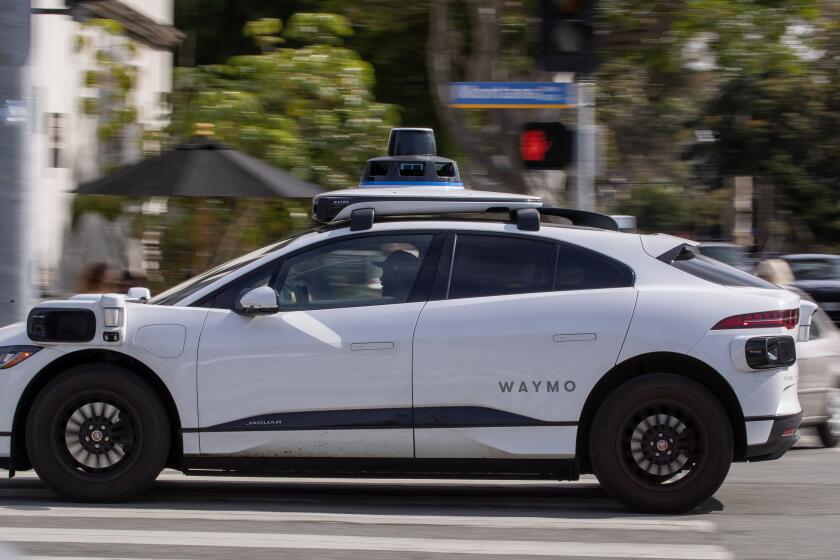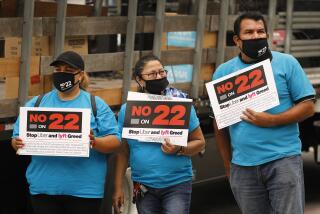Column: Two Uber drivers read the fine print — and won millions for California gig workers
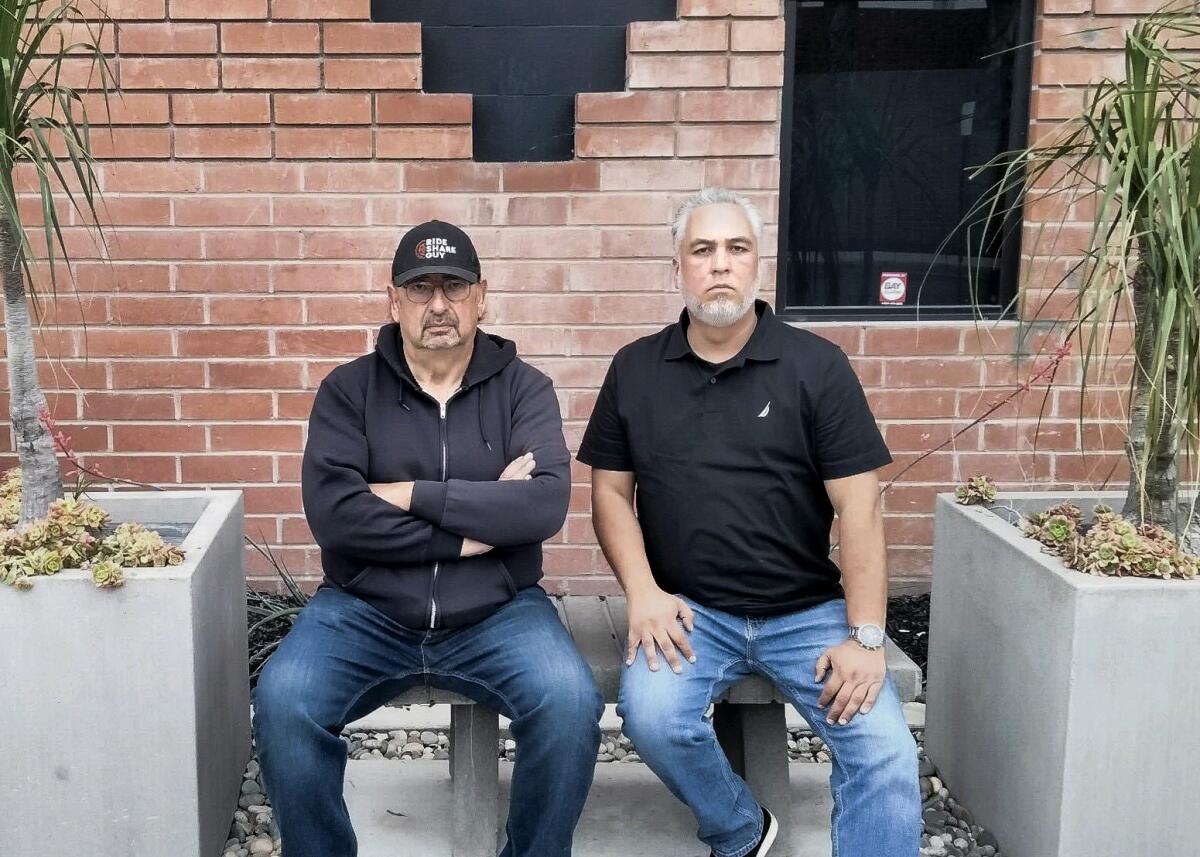
- Share via
Pablo Gomez has been a full-time Uber driver since 2019. He takes pride in knowing how to maximize his earnings on each trip he takes. That means knowing the right times to drive, which rides to accept and which to pass up — and it also means knowing the letter of the law that governs his trade. In particular, it means knowing Proposition 22, the controversial ballot measure that passed in 2020 and became law in 2021, inside and out.
For the gig drivers of California, Gomez’s eagle-eyed attention to detail, paired with a fellow driver’s fighting spirit, resulted in a windfall that could be worth hundreds of millions of dollars.
Proposition 22, you might recall, overrode part of AB 5, a law that classified gig workers as employees, entitling them to benefits and protections. The ballot measure instead carved out app-based gig workers as independent contractors and put in place a raft of better-than-nothing half measures: Instead of full healthcare coverage, gig workers got a healthcare subsidy, if they worked enough hours to qualify. Instead of a minimum wage, drivers got a minimum earnings guarantee — but only for “engaged” miles, not time spent between rides.
It’s a long and confusing law, but Gomez studied it when it passed and took note of one of its more arcane benefits: a provision that grants drivers making the bare minimum a small reimbursement for vehicle expenses. Starting in 2021, gig app companies were to pay drivers 30 cents per mile driven on the job. But Proposition 22 also stipulates that every year, that rate will be raised to keep pace with inflation. Since inflation was 6.8% in 2022, that fee was supposed to be bumped up 2 cents. In 2023, it should have gone up 2 more, to 34 cents a mile.
This is where it gets interesting. As far as Gomez could tell, no such increase ever took effect. As of early this year, drivers were still being paid 30 cents a mile.
Now, 2 to 4 cents a mile might not sound like much, but to gig workers driving hundreds of miles a day, it adds up fast. In the course of a year, those pennies can add up to hundreds, even thousands of dollars. Multiplied across the nearly 1.3 million gig app drivers in California, it can add up to tens, even hundreds of millions of dollars.
In March, Gomez was having dinner with a colleague, Sergio Avedian. They’d texted and corresponded a lot, but never met in person. Avedian is a longtime Uber driver too, and in recent years, he’s turned to advocacy as well. He’s a senior contributor at the Rideshare Guy, where he runs a podcast that tackles the ins and outs of ride-hail policy and gig working life. I’ve highlighted some of his work in this column before.
The seemingly random firing of drivers is one way ride-hail companies keep workers powerless. Can’t they bear the cost of humane engagement?
Avedian is a force. He keeps an Excel spreadsheet documenting every one of the thousands of rides he provides each year, logging his fare, miles traveled, pay and so on. He gathers data from other drivers, many of whom now listen to his show. He likes driving for the ride-hailing companies, but he is hellbent on keeping them honest.
During his meal with Gomez, Avedian started getting calls from reporters to comment on some news — Proposition 22, which had been struck down by a Superior Court in Alameda County in 2021, had been upheld on appeal. All the commotion reminded Gomez of the weirdness with the vehicle expenses rate. He mentioned it to Avedian. “Sergio immediately started doing math in his head,” Gomez recalls.
When they pored over the law, they realized that Proposition 22 had technically saddled the California treasurer’s office with the task of calculating and publishing the adjusted rate each year, which, as far as they could tell, it had not done.
“For 18 months nothing was done,” Avedian said. “I missed 18 months! Everybody missed 18 months! I was like, ‘Holy s—, this could be a lot of money!’”
With reams of data at their disposal, companies like Uber and Amazon are demolishing the notion that people who do the same work should receive the same pay for it.
There are some 1.3 million gig workers in California, according to industry reports, including over 209,000 Uber drivers and 200,000 DoorDash drivers. “I’m telling you, it’s going to be like $100 to $300 million,” Avedian said, offering some back-of-the-envelope math to support his estimate.
On April 13, Gomez called the state treasurer’s office and asked about the rate adjustment. The first person he reached directed him to the IRS’ webpage for information on mileage-based tax deductions. After explaining what he was after and spending some time on hold, Gomez was assured the rate would be published soon.
Weeks went by. After conferring with Avedian again, Gomez tweeted at Fiona Ma, the California treasurer, asking why the rate hadn’t been changed yet.
Avedian boosted the tweet too, and, a week later, on May 10, Ma replied, announcing that the rate adjustment had been published. Almost immediately, perhaps fearing the prospect of a class-action lawsuit, Uber and DoorDash began sending the back pay to drivers. Avedian, who drives only part time and picks only profitable rides, got $85 from Uber; his wife, who drives part time too, got more than $200 from DoorDash.
Remember, drivers get paid only if they’re making the minimum rate, and many ride-hail drivers exceed it. But there’s one kind of driver who tends to make the minimum, as they rely on tips for income — delivery drivers.
“Delivery is horrible for base pay,” Avedian says. “If you are a full-time Uber Eats or Grubhub driver you’re getting over a thousand dollars [in mileage reimbursement], guaranteed.”
All said, the catch-up payments stand to be a huge boon to gig workers and delivery drivers statewide. Uber, whose business spans ride hailing and food delivery, won’t say how much it’s paid out, but the anecdata suggest it’s a lot. (As of this writing, Uber, Lyft and DoorDash have begun issuing back pay; Instacart and Grubhub have not. Since the payout applies to all companies that work with independent contractors, it applies to Amazon Flex, Target’s Shipt and Walmart’s Spark as well, though those companies tend to pay above the minimum.)
So, what happened? Why weren’t drivers getting the full rate all along? Consumers are paying for it, after all. As Avedian points out, every time you take a Lyft or order Uber Eats, you’re paying an extra 75 cents to $1 for a fee marked California Driver Benefits, which is then ostensibly used to pay for things such as health subsidies and this mileage fee. The resulting pile of money is one the app companies got to sit on for a year and a half, earning interest or investing it or using it to cover losses or so on.
Waymo, Google’s robotaxi spinoff, has come to Los Angeles. What happens when autonomous vehicles invade the traffic capital of the country?
This is where it gets murky. When I asked Uber why it didn’t pay drivers the adjusted rate as Proposition 22 requires it to do, the company blamed the treasurer’s office for not publishing the adjusted rate.
“As outlined in the proposition, the California Treasurer’s office is required to update per-mile compensation for vehicle expenses based on inflation,” Uber spokesperson Zahid Arab told me in an email. “That office released those updates last week, both for 2022 — 18 months late — and for 2023. We are in the process of making all necessary adjustments to ensure the benefits afforded to drivers by Prop. 22 will continue to be met.”
The state treasurer’s office, meanwhile, hit back.
“The characterization that the treasurer’s office was somehow late posting the adjustment is misinformed and disingenuous,” Joe DeAnda, a spokesman for the treasurer’s office, said in a statement.
Proposition 22 was struck down as unconstitutional in August 2021, he said, so the office deemed the law unenforceable. “Given the uncertainty of the law’s status,” he said, “and the ongoing legal activity, the State Treasurer’s Office refrained from publishing the adjusted rate, and only felt it prudent to do so when the law formally took effect this March.”
DeAnda said adjustments will be calculated and published every January.
Now, one reason that the treasurer’s office might be defensive about the timeline here is that Ma is running for lieutenant governor in the next election cycle.
She provided a statement on the matter too:
“More money going in the pockets of drivers is a good thing,” she said. “App-based delivery services have become a major source of economic activity for California, and the provision that requires the State Treasurer’s Office to provide annual adjustments to the vehicle expense reimbursement rate is critically important since none of it would be possible without the drivers’ willingness to use their own vehicles to work. I encourage all drivers to check their accounts for these payments and hope all companies will quickly issue reimbursements if they haven’t already.”
The treasurer’s office says it has already been flooded with calls from drivers looking for their payments. But it has no ability to pay them — that duty falls to the gig app companies themselves. The treasurer’s responsibility begins and ends with adjusting that rate (you can see it at the top of the treasurer’s website now).
The treasurer has heard from some drivers that Uber is encouraging them to contact the treasurer’s office, despite knowing it has no power to provide funds of any kind to them. (It also might be noted that although the law charges the state with calculating and publishing the rate, it’s not entirely clear that the gig app companies aren’t responsible for paying the adjusted rate even if the state doesn’t do so.)
It is, in short, a big, stinking mess. And although Uber tries to throw the treasurer’s office under the bus, and that office says it couldn’t make the adjustment on time due to legal uncertainty, guess who gets the short end of the stick? The gig workers who were barely making minimum wage to begin with.
And that, says Veena Dubal, a professor at the UC Hastings College of the Law, is the entire point. This was what the gig app companies that wrote Proposition 22 were trying to do — make a big, stinking mess that would be perennially hard to sort out.
“It was specifically written to be confusing,” Dubal tells me. “To everyone. Voters, consumers, drivers, state actors.”
For the record:
3:04 p.m. June 1, 2023An earlier version of this column stated that app-based ride-share drivers are not eligible for the IRS’ vehicle mileage deduction rate. They are eligible to claim this deduction on their income taxes.
That’s because, as Dubal’s scholarship has shown, gig app companies, which have never been profitable, depend on taking every conceivable opportunity to squeeze workers, engaging in practices such as algorithmic wage discrimination and rampant corner-cutting.
Again, this is by design.
“I bet if you asked any given voter what Prop. 22 did, they would say, it benefits workers!” Dubal says. “In fact, it took rights away from workers and dramatically lowered the wages they were owed under the law. ... I can only imagine the companies hoped no one at the treasury’s office would notice this strange new responsibility so they could nickel and dime drivers.”
Those companies, which spent more than $200 million campaigning for Proposition 22, didn’t count on drivers like Gomez and Avedian, perhaps, to claw back what was rightfully theirs.
“Honestly, it feels great,” Gomez says. “I hope this brings a bright spotlight on a broken system that exploits workers and consumers alike.”
Avedian, for his part, is already moving on to the next challenge. He wants to take stock of what it is that the gig app companies are doing with all the money they get under the California Driver Benefits fee they slap on the millions of rides the app companies facilitate every day. There’s no public accounting of how that money gets used, and none required by the letter of the law.
And we’ve already seen what happens when no one forces the gig app companies to meet it: Nothing.
- Share via
Watch L.A. Times Today at 7 p.m. on Spectrum News 1 on Channel 1 or live stream on the Spectrum News App. Palos Verdes Peninsula and Orange County viewers can watch on Cox Systems on channel 99.
